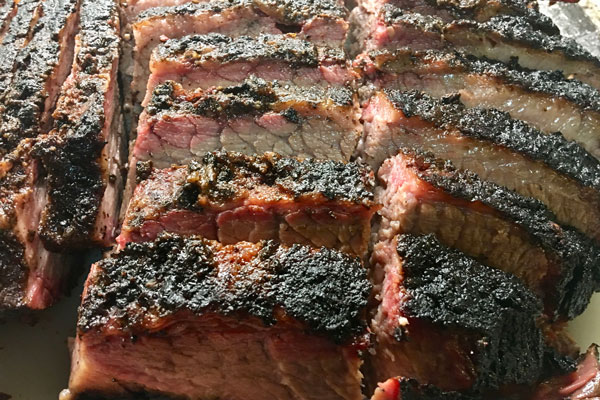The Economics of Texas BBQ It's Not Your Grandpa's Barbecue Anymore
However you spell it — barbeque, bar-b-que, bar-b-q, BBQ — Texas-style smoked meat has entered the rarefied atmosphere of cultural phenomenon. Beyond trendy, it's now a bona fide thang, y'all.

Texas-style smoked brisket remains a hot commodity throughout the state.
Shall We Gather at the Smoker?
Worshipers queue up two hours early at lunchtime outside the modest temple that is Franklin Barbecue in Austin.
Fifty miles northeast in tiny Lexington, rustic Snow's BBQ has become a barbecue mecca, despite being open only on Saturday mornings and, like Franklin's, serving until there's none left to sell. Snow's topped the Texas Monthly™ 2008 list of top 50 BBQ joints and has been lauded in The New Yorker magazine.
Cooper's Old Time Pit Bar-B-Que (four locations, with two more in development) served a million customers last year. Cooper's Llano headquarters, a no-frills favorite of deer hunters and bluebonnet lovers alike, has been featured in The New York Times.
H-E-B not only sells meat to barbecue at home, but select stores now cook and sell barbecue on site, for dine in or take out.
Growth Spurt
Barbecue is booming, confirms veteran sales manager John Caddell of PAK Quality Foods in San Angelo. "It gets bigger and bigger and bigger every year," he says.
Caddell recounts that 10-15 years ago, PAK was shipping about 5,000 pounds of meat every two weeks. Now, it's 300,000 pounds each week, much of it to be used for barbecue, including traditional Mexican-style barbacoa. Consequently, PAK has expanded to Fort Worth and may move into two other states.
Since taking over Cooper's in 1986, owner Terry Wootan reports sales volume has increased every year but one.
CHD Expert, a food service market research firm, has identified more than 2,500 Texas barbecue outlets, up 12 percent from what Texas Monthly reported four years ago. Turnover notwithstanding, Texas maintains one of the nation's highest per-capita ratios of patrons to purveyors.

Backyard pitmasters help drive the BBQ economy.
'Cue's Coming of Age
Like artisan bread and craft beer, variations on the conventional "four meats, four sides" fare of traditional barbecue joints are now in vogue, such as breakfast nachos, flavored sausages, Korean sticky ribs, chipotle cole slaw, potato buns and more.
"It's all about the meat," Wootan declares, invoking Cooper's slogan, "but you've got to have good sides, too."
Diversification doesn't come cheap, of course. At one Austin walk-in establishment operated by a next-generation member of a venerable Central Texas barbecue clan, the cheapest sandwich on the menu goes for $12. An upscale, nouveau Southwestern restaurant in downtown Austin serves brisket with pickled escabeche (marinated meat or fish) and pork ribs rubbed with fennel and coriander, each at $21 per entree.
Some of this exorbitance is sheer economics, where demand is the driving force behind the price. The law of supply and demand extends to sourcing superior quality fresh meats. Caddell says roughly half of PAK's sales are to grocers, much of it to be made available in stores for backyard pitmasters.
Moreover, beef prices have risen steadily in recent years. Caddell notes that brisket, still the main attraction, has gone up 300 percent, from less than $1 to more than $4 a pound.
BBQ-U
"Doin' the ‘cue" has graduated from DIY vocation to scholarly pursuit, thanks to the Aggies. Texas A&M University (TAMU) – College Station's meat science faculty teach courses in barbecuing as well as a "Pork 101" seminar.
The Texas Barbecue Program at TAMU includes a festival, annual town hall meeting and two yearly camps (co-sponsored by Foodways Texas at the University of Texas at Austin). Even barbecue god and James Beard Awardee Aaron Franklin has done cooking demonstrations at Camp Brisket.
The Real Deal
Although Cooper's offers pork chops and cabrito (roast goat), Wootan strives for simplicity: "If it's round, don't try to make it square."
That could be the motto at Underwood's in Brownwood, a family-owned cafeteria specializing in barbecued beefsteak and fried chicken. After decades of overextension (30 stores at one time), only the original restaurant remains in operation.
"We are what we are," stated co-owner Paul Underwood. He believes barbecue has become a form of entertainment.
"People are looking for an experience," he explains, adding that, due to the internet, "Restaurants are the only thing that gets folks out of the house."

Customers line up early on Saturday mornings to get a taste of Snow’s BBQ in Lexington, before they sell out of meat.
Snow's owner/operator Kerry Bexley told Eater in 2015 that he can't explain the weekend pilgrimages. Maybe it's his 80-something pitmaster, Barbecue Hall of Famer "Tootsie" Tomanetz.
Other influences include TV cooking shows, festivals and cook-offs, even the paleo diet. But the desire for authenticity seems to permeate the 'cue-niverse, now encompassing New York City. Hometown Bar-B-Que in Brooklyn does it Texas/Southern style with a decidedly Big Apple flavor (e.g., pastrami bacon and smoked turkey on brioche Texas toast).
"Folks want to try something good," Wootan says. "There's nothing better than good barbecue ... and nothing worse than bad barbecue."
Interested in enrolling in the Texas barbecue courses, camps and workshops offered by Texas A&M University? Discover the art and science of barbecue by visiting their Texas Barbecue website to learn how.

